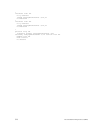
response, the querier removes the group from the list associated with forwarding port and stops
forwarding traffic for that group to the subnet.
IGMP Version 3
Conceptually, IGMP version 3 behaves the same as version 2. However, there are differences.
• Version 3 adds the ability to filter by multicast source, which helps multicast routing protocols avoid
forwarding traffic to subnets where there are no interested receivers.
• To enable filtering, routers must keep track of more state information, that is, the list of sources that
must be filtered. An additional query type, the Group-and-Source-Specific Query, keeps track of state
changes, while the Group-Specific and General queries still refresh the existing state.
• Reporting is more efficient and robust: hosts do not suppress query responses (non-suppression
helps track state and enables the immediate-leave and IGMP snooping features), state-change reports
are retransmitted to insure delivery, and a single membership report bundles multiple statements from
a single host, rather than sending an individual packet for each statement.
The version 3 packet structure is different from version 2 to accommodate these protocol
enhancements. Queries are still sent to the all-systems address 224.0.0.1, as shown in the following
illustration, but reports are sent to the all IGMP version 3-capable multicast routers address 244.0.0.22, as
shown in the second illustration.
Figure 39. IGMP Version 3 Packet Structure
386
Internet Group Management Protocol (IGMP)


















